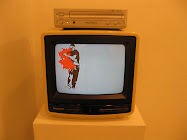skip to main |
skip to sidebar
Recently, worrying about the economy has taken a seat at the back of the bus. Unfortunately for Houston we’re always a little behind the curve, so don’t think that we’re done with the bad news yet. Even art writing has gotten over the little doom-and-gloom session despite the fact that we’re in the midst of a drastic realignment as destructive as the 1970s. Hell, it may even be as big as 1871, when the growing tide of Impressionism in Paris melded with heightened political strife to bring about the fall of the old artistic order. Changing economics as well as an evolution in art’s incestuous relationship with its own history brought the market and academia to a grinding halt as their previous paradigm became worthless. Perhaps gigantic museum institutions, non-profit grad-school feeders and globe-trotting gallerists will go the way of the hierarchy of painting, repeatedly copying classical statues and court painters.

In the summer of 1870, France declared war on Prussia, and the ill-equipped French army was soundly beaten soon after. Along with the city’s proud working class, artists like Manet and Courbet joined the efforts to save Paris. Declaring surrender after a winter-long siege of the capitol, the French capitulated to their invaders, and Paris was occupied by foreign forces. This moment in time is where the modern restaurant came from, as foreign soldiers hiding from their officers implored locals to bring them wine and beer “Bistro!” (‘quick’) which enterprising entrepreneurs didn’t understand, but threw up on signs as soon as they could to attract some of the few people in town who had money. After the occupation ended- the city ravaged by marauding soldiers and the government in tatters- anarchists, socialists, factory workers and intellectuals filled the vacuum, declaring March 28th the beginning of the Paris Commune. The social experiment was short-lived, ending in the bloody slaughter of the Communards by their own countrymen. The last holdouts in the suburb of Belleville fell on May 28th. Hundreds were executed and buried in a mass grave. The government was restored, but the world had changed drastically.

Really, there was a sea change- a forty-year battle between classicism and realism became a moot point in the face of technological change and changing audience expectations. Art was no longer a faithful image of the world useful for teaching moral or immoral lessons; it was a mark of individualism and a way of seeing the world. Mass printing and advertising, photography, philosophy and capitalism all unwittingly conspired to destroy an entire way of looking at the world. The same process carried out by iPhones, facebook, digital printing, complexity theory, environmentalism and communitarian cultural movements is happening today, flustering our institutions, leaders and businesses. One hundred and thirty-eight years after the Paris Commune, we shouldn’t be too scared to eat the horses and the cats around us, to defend the walls against impossible odds, or to rewrite the social bonds that hold us together. It’s only art after all.


























0 comments:
Post a Comment